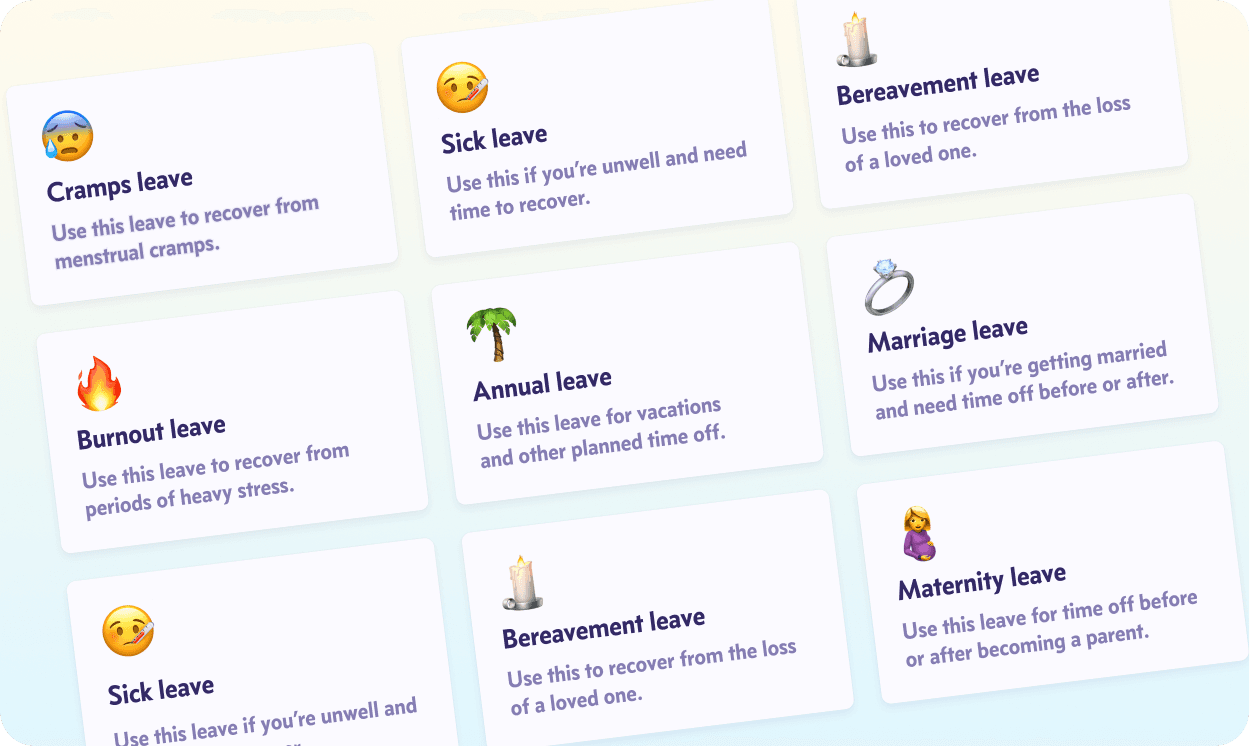Supporting employee work-life balance through leave policies
Apr 28, 2023

Meet Jennifer, a passionate employee who always goes the extra mile to get her work done. She's committed to her job, but she also values her time with her family and friends, wishing she could strike a better work-life balance.
Then, one day, her manager discovers the incredible benefits of thoughtful leave policies, and the office dynamic is transformed for the better — employees are happier, more engaged, and more productive, as they now have the support and flexibility to manage their work and personal lives effectively.
In our constantly connected world, it's hardly surprising that many employees, just like Jennifer, grapple with finding the ideal work-life balance. The boundaries between work and personal life often blur, making it challenging to switch off from job demands. Fortunately, companies can create a healthy balance for their employees by implementing supportive leave policies.
In this article, we'll explore the role of leave policies in promoting work-life balance and how using a SaaS management tool can make the process even more seamless.
Understanding work-life balance
First things first, what is work-life balance? Simply put, it's the equilibrium between an individual's professional and personal life. It means giving employees the opportunity to excel at work while also enjoying their life outside of it. It's not just about clocking out at 5 PM sharp; it's about enabling employees to feel fulfilled and satisfied in both aspects of their lives.
The benefits of work-life balance are numerous. Employees who feel they have a good work-life balance tend to be happier, healthier, and more productive. They experience less stress, burnout, and absenteeism, and are more likely to stay with the company long-term. Moreover, organisations that prioritise work-life balance are often perceived as more attractive to prospective employees.
Key leave policies to promote work-life balance
Now that we know the importance of work-life balance, let's dive into the types of leave policies that can make a difference for employees like John:
Paid time off (PTO)
This is the foundation of any leave policy. Encourage employees to take their PTO, whether it's for a vacation or a staycation. Flexible PTO policies allow employees to recharge and come back to work with renewed energy.
Parental leave
Becoming a parent is a life-changing event, and it's crucial for companies to support their employees during this transition. Offering maternity, paternity, adoption, and surrogacy leave can help parents bond with their new child and adjust to their new roles.
Caregiver leave
Many employees have caregiving responsibilities for sick, disabled, or elderly family members. By offering caregiver leave, companies can show their support for employees during these challenging times.
Sabbatical leave
Long-term employees may benefit from an extended break to pursue personal goals or simply recharge. Sabbaticals can foster creativity, reduce burnout, and contribute to an employee's overall satisfaction with their job.
Mental health days
Encouraging employees to take mental health days when needed can help reduce stress and burnout. This not only benefits the individual employee but also contributes to a healthier work environment overall.
Best practices for implementing leave policies
Creating an environment that supports work-life balance requires careful planning and execution. Here are some best practices for implementing leave policies that effectively address employees' needs:
Clear communication
Ensure your leave policies are well-documented and easily accessible. Regularly remind employees of their leave benefits and keep them updated on any policy changes. Use multiple channels, such as emails, team meetings, and company intranet, to reinforce the information.
Encourage usage
Lead by example and take leave when needed. Actively promote the benefits of using leave and create a culture where employees feel comfortable doing so. Celebrate employees who make use of their leave benefits and share stories that highlight the positive impact of work-life balance on the individual and the team.
Monitor and review
Track leave usage patterns to identify trends and areas for improvement. Regularly evaluate and update your policies to ensure they remain relevant and effective. Use data-driven insights to make informed decisions about policy adjustments, and be open to adapting your policies as your organization and its needs evolve.
Get employee feedback
Engage employees in the development of leave policies and use their feedback to make improvements. Encourage open communication and listen to their concerns and suggestions to create policies that truly address their needs. Conduct regular surveys or hold focus group discussions to gather insights and understand how policies impact employees' work-life balance.
Train managers
Equip managers with the knowledge and tools they need to support their team members in using leave benefits effectively. Provide training on the importance of work-life balance, the company's leave policies, and how to manage workload and coverage during an employee's absence. Encourage managers to be proactive in discussing leave options with their team members and to support their employees in finding the best solutions for their individual needs.
Ensure flexibility and inclusivity
Design leave policies that cater to the diverse needs of your workforce. Consider offering flexible work arrangements, such as remote work or flexible hours, in addition to leave policies, to help employees better manage their work-life balance. Ensure that your policies are inclusive and consider the needs of employees with different family structures, cultural backgrounds, and personal circumstances.
Enable transparency and fairness
Develop clear guidelines and criteria for approving or denying leave requests to ensure consistency and fairness across the organization. Make sure that all employees, regardless of their role or seniority, have equal access to leave benefits and that the approval process is transparent and unbiased.
Now that we've covered the types of leave policies and best practices for implementing them, let's discuss how a SaaS management tool can help streamline the process.
Benefits of using SaaS management tools for leave tracking
SaaS management tools can save time and reduce administrative burdens by automating leave tracking, requests, and approvals. These tools provide a central location for storing and managing leave data, making it easy for both employees and managers to access and update information.
SaaS management tools can help automate the leave request and approval process, reducing manual tasks and potential errors. By streamlining these processes, managers can quickly approve or deny requests and employees can easily track their leave balances and plan their time off accordingly.
Features to look for in a SaaS management tool
When choosing a SaaS management tool for your leave policies, consider features such as customisable leave types, automated accruals, calendar integration, and reporting capabilities.
Additionally, look for tools that offer mobile access and user-friendly interfaces, making it easy for employees to request leave and managers to approve it.
The final word
In conclusion, supporting work-life balance is essential for both employees and organisations. Implementing well-designed leave policies can make a significant impact on employees' wellbeing and overall job satisfaction.
By following best practices for communication, encouraging usage, monitoring, and reviewing policies, and integrating with SaaS management tools, companies can create a supportive work environment that fosters productivity, loyalty, and happiness.
Remember, a happy employee like Jennifer is not only more likely to stay with the company but also to contribute positively to its success. So, don't underestimate the power of well-crafted leave policies in achieving the perfect work-life balance for your team.
Happy employees make for a happy workplace, and a happy workplace makes for a thriving business!



